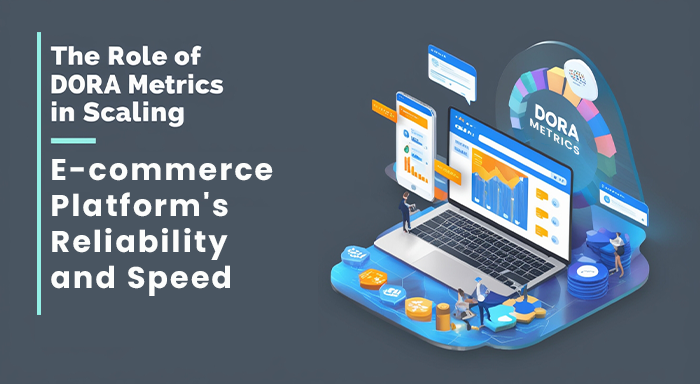Your e-commerce digital security is pegged to a few main components – transaction security, data safety, and regulation compliance. For enhancing the speed, reliability, and security of your e-commerce platform, you must trust the DORA framework.
The framework mainly depends on the insights taken from the metrics like deployment frequency, meantime recovery, Change Failure Rate (CFR), and lead time for change, etc. They allow online businesses to operate with fixed bottlenecks, online platform deployment, and minimized downtime. Dora metrics also help in enhancing the overall satisfaction level of the customers. They are also quite effective in improving operational processes and system stability, and ensuring quick updates.
What DORA metrics mean
DORA is an acronym for DevOps Research and Assessment. It was developed as the benchmark of success measurement in process performance until maturity. The metrics are quite helpful for project managers as they give insights related to performance of the team. In e-commerce, DevOps DORA acts as the standard for measuring platform performance, ensuring consistent service delivery.
Dora metrics tools are designed to boost e-commerce software performance through enhanced development procedures and understanding. The DORA measurement standards help online business platforms keep lead time, deployment frequency, and recovery from failures in check. These companies do quick updates and increase system reliability once they accelerate DORA metrics. They require a comprehensive understanding about DORA metrics and how they can help identify bottlenecks and enhance workflows through data. This is a better way to sustain a reliable platform and ensure the business stays competitive.
How Dev Ops metrics help with scaling e-commerce reliability
- Enhanced trust and reliability. Minimum downtime and quick recovery after issues develop customer trust. It keeps the system reliable ensuring consistent service delivery 24/7.
- Optimized system speed. Important activities like quick deployment and updates are important to ensure the flexibility of the system. It also improves the overall speed of the system, ensuring competitiveness and agile nature of the system. This is an important aspect of satisfying customer needs in real-time.
- Enhanced efficiency. Efficiencies are ensured through parameters like minimum downtime, regular updates, automation, etc. Automation helps in reducing lead time and improving deployment frequency.
- Avails data for decisions. DORA metrics avails data that help online businesses decide on business needs. The quality data allows businesses to get a complete view of their systems, which helps them figure out how effective they are. They can also recognize the service gaps and vulnerabilities present in the system.
Components of the DORA framework
E-commerce platforms benefit from DevOps DORA through enhanced customer experience, platform reliability, and speed. The benefits of the framework go well-beyond ensuring regular updates for the platform and fast response to slight variation. Using this framework, online businesses can ensure that the buyers get an optimal experience and reduced downtime frustrations.
Online business stores that implement the Dev Ops metrics operate better than their competitors. They build a stable system that attends to shopper needs quickly and is always available. The DORA framework comprises four main elements, which are valuable for the speed and reliability of an ecommerce platform.
- Mean Time to Recovery (MTTR). Determines the rate of recovery after a data breach or system failure.
- Deployment Frequency (DF). Shows the rate of system updates implemented on the system.
- Change Failure Rate (CFR). Show the rate of negative effects such as bugs and downtime due to patch updates.
- Lead Time for Changes (LT). Show the time taken to add features in the code and activate it in the system.
The role of the Dev Ops metrics components in e-commerce
E-commerce entrepreneurs should understand how the DevOps framework works to help them optimize their business workflows. Optimized online business processes lead to more stability in the system. Overall performance is improved and consequently, online businesses get more sales due to improved customer satisfaction.Let's discuss the role of each DevOps DORA metric.
Lead Time for Changes
Lead Time for Changes is a DORA framework metric that provides insights into the time taken to implement changes in code and launch it on the platform. This time should be minimal to ensure the e-commerce platform operations are not affected by these updates. Delays could cause customer loss if they cannot connect to the system quickly.
Systems with a shorter lead time can add new products or fix bugs and keep the system running without the customer noticing any impacts. Online entrepreneurs should monitor the system closely to reduce lead time as much as possible. It enables platforms to be more competitive in the market and improve their customer satisfaction levels.
Deployment Frequency
Deployment Frequency measures how often an e-commerce platform releases changes, fixes bugs, and upgrades the system. Customer needs change quickly in online businesses. This makes it necessary for online businesses to keep track of these changes so that they can mold their services accordingly and take advantage.
Frequent system updates are critical in ensuring customers get consistent or better shopping experiences. However, it is important for these updates to not impact system performance or lead to loss of customer cart items. There should also not be any connection issues or disruption in payment records due to these updates. This is especially important to consider when there are abrupt market variations, time of peak seasons, or sudden increase in online traffic.
Change Failure Rate
The role of the change failure rate is to ensure the system stays stable during updates or immediately after. Customers might shop elsewhere if updates to the system cause crushes, introduces bugs, or leads to downtime. Tracking failure rate ensures teams identify the cause of negative impacts and correct them. Apart from improving system performance, failure rate is also greatly decreased.
Mean Time to Recovery
This metric ensures the system bounces back to smooth operations after downtime, a crash, or a data breach. This calls for measures that allow quick turnaround time allowing business to continue running normally. This attracts trust from customers who view the online platform as reliable and ready to deliver uncompromised services.
Conclusion
Competition in e-commerce increases daily as new players, products, and services are added to these spaces. DORA metrics act as a guide for measuring how effective and fast a platform is. It enables online businesses to monitor the recovery speed after failures. It also helps them track changes in the market or how responsive DevOps is to the changes in the system. Businesses can get insights on frequency of iteration and whether the updates are impacting service-delivery. Overall, these updates are beneficial for ensuring a smooth experience for the customers.
Related Posts:
Marketing Made Easy: A Simple Guide to Success in E-commerce Ads
CRM for E-commerce Business: For Sales, Marketing, & Support



